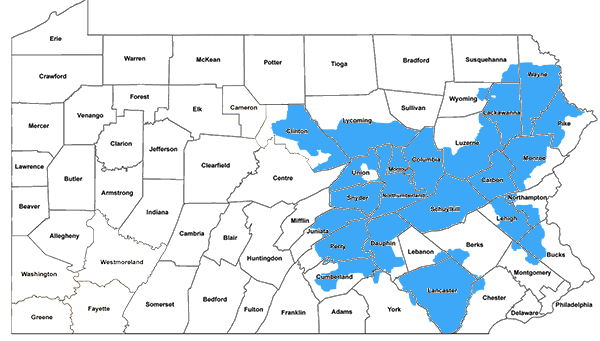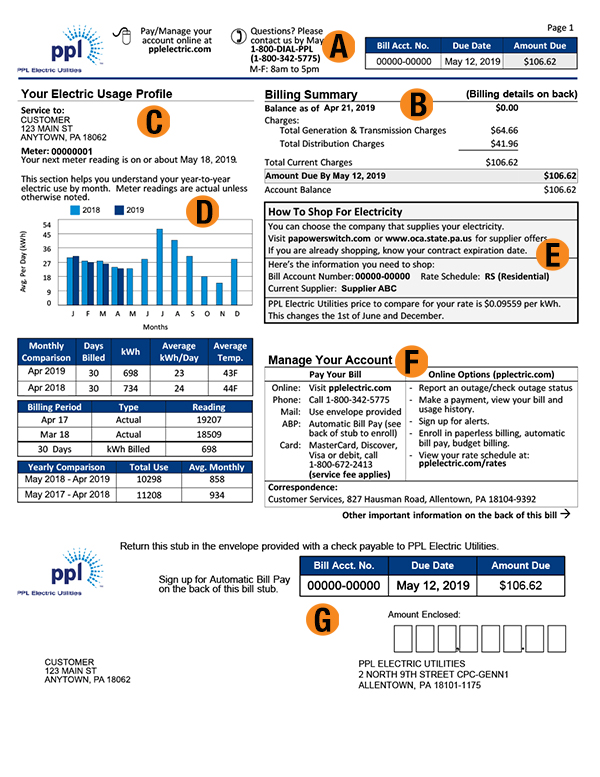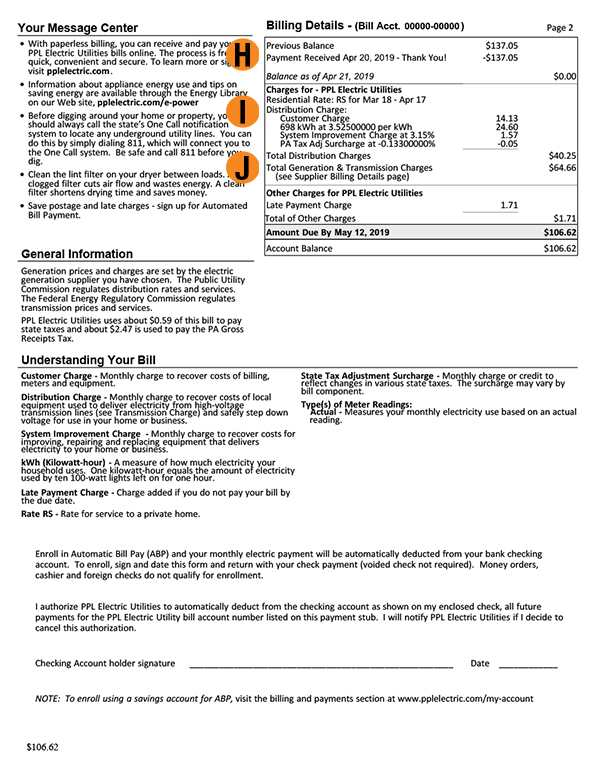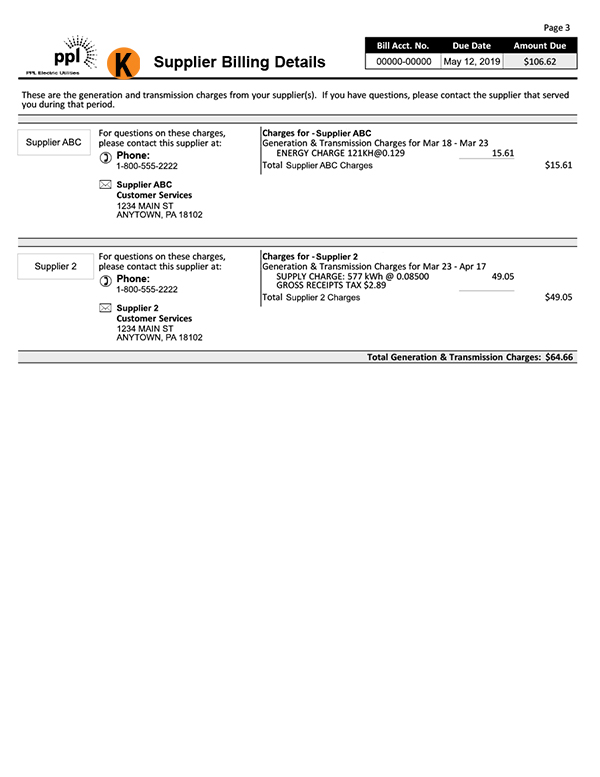Shop for Electricity and Natural Gas in the Penn Power Footprint
Compare PP&L Electricity Rates and Save.
Shop for the Best Electricity or Natural Gas Rates for Your Home:
About PPL
In 1920, eight central Pennsylvania utilities merged to form Pennsylvania Power & Light. Today headquartered in Allentown, PA, PPL Corporation owns and operates PPL Electric Utilities, LG & E and KU Energy, PPL Global, and Safari Energy. Currently, PPL Electric focuses on its transmission and distribution operations, maintaining about 50,000 miles of power lines and support installations in Pennsylvania. Through its PPL Foundation, the utility helps with programs that help schools, food banks, youth sports, and other nonprofit organizations in 29 PA counties.
PPL Service Territory

PPL distributes electricity to 1.4 million customers in some or all of these central and eastern Pennsylvania counties:
| Berks County | Bucks County | Carbon County | Chester County | |
| Clinton County | Columbia County | Cumberland County | Dauphin County | |
| Juniata County | Lackawanna County | Lancaster County | Lebanon County | |
| Lehigh County | Luzerne County | Lycoming County | Monroe County | |
| Montgomery County | Montour County | Northhampton County | Northumberland County | |
| Perry County | Pike County | Schuylkill County | Snyder County | |
| Susquehanna County | Union County | Wayne County | Wyoming County | |
| York County | ||||
PPL serves these cities:
| Allentown | Harrisburg | Lancaster | Scranton | Wilkes-Barre |
How to Start New PPL Service
To start service with PPL, go to their Start, Stop, Or Move Service web page. Select a date up to 40 days in advance, and provide proof of ID to start service. Valid forms of identification include a driver's license, state-issued photo ID card, passport, resident card, visa, or a military ID.
PPL may check your credit, and charge a deposit to start service based on your credit history. Not everyone will require a security deposit, and in some instances, the security deposit may be waived.
You'll need to give the following information when you apply for service:
- Name
- Date of birth
- Address where electricity service is needed
- Phone number
- Social Security number
Will I need to pay a deposit?
Pennsylvania electric utilities can charge a deposit based on a customer's credit worthiness. The amount cannot be greater than two months of estimated usage. Customers have 21 days after the utility sends the deposit request notification to make a payment. However, customers have three months to pay the full deposit.
Customers can contact PPL customer service at 1-800-342-5775 or via the PPL Customer Service webpage.
PPL Electricity Rates
Understand Deregulation in Pennsylvania
When Pennsylvania deregulated its energy market in 1997, customers were allowed to shop around for their electricity supplier, rather than be bound to the local utility rate. However, each utility taking part had to sell off their generators and become delivery-only companies.
To protect energy customers from service disruptions the PA PUC requires utilities to provide electricity supply at a default rate without mark up to customers who choose not to shop for a retail supplier.
These utility default rates are also called the "Price to Compare" or PTC. These rates are overseen by the PA PUC.
What is the difference between PPL and a retail electricity supplier?
The primary difference between PPL and an electricity supplier is that PPL owns and maintains the distribution network of poles, lines, and meters that bring electricity to your home.
Customers should contact PPL when they have a problem with their billing or cannot pay the amount due according to their monthly statement. They should also contact PPL in case of an emergency or outage.
Lastly, PPL is the “last resort” supplier if your supplier stops serving customers in PA.
What are PPL delivery and supply charges?
Pennsylvania residential customers now pay separate charges for the cost to deliver their electricity and for the amount of electricity supply that they use.
Because PPL owns and maintains the the distribution network, all electricity customersmust pay a distribution charge no matter which supplier they have. All customers pay the same rate depending on their service class.
Utility distribution rates are overseen by the PA PUC and can periodically change. Assuming an average usage of 864 kWh per month, the PPL distribution portion of a bill could look like this:
| Rate of $0.04332 per kWh | Monthly Customer Charge | Total | |
| Monthly Distribution Charges (excluding riders) | $37.43 for 864 kWh Used | $17.94 | $55.37 |
Supply charges reflect the price for the electricity that a consumer actually uses. PPL customers may choose the "Price to Compare" (PTC) for their electricity supply. However, PA consumers can also choose to buy electricity from competitive retail electricity suppliers.
Retail electricity suppliers purchase energy from generator companies on the the wholesale markets and sell the actual power a customer consumes. Rates vary between competing retail suppliers. Customers can switch to a new retail supplier at any time but may incur an early termination fee if they break a contract with a retailer.
What is the PPL Price to Compare (PTC)?
The Price to Compare is the price the utility pays generator companies for electricity. It includes the price to generate the electricity, as well as the cost to transmit it over high voltage transmission power lines to PPL's local electrical switch yards. From there, the electricity is distributed throughout the PPL controlled grid for delivery to homes.
PPL sets its PTC rates by holding auctions twice a year to find the lowest priced source of electricity. The rates are approved by the PA PUC. As a result, PPL's PTC rates change every June 1 and December 1. Additionally, when the auctions are over, the PAPUC must approve the prices for both the generation supply and transmission. For customers, it means these electricity rates can vary with the seasons; low some months, and higher during others.
Understand your PPL Bill
Your PPL bill includes a substantial amount of information that may be confusing to customers. To help you better understand your usage and where the amounts come from, we break down the most important items below.
PPL Sample Bill



- A: Account Information. This includes your name, 10 digit PPL account number, the bill's due date period, and the payment amount due.
- B : Billing Summary. This shows an overview of account balances, current charges, the date due, and the amount due.
- C: Electric Usage Profile. The first part shows the service address, the meter number for that address, and the date of the next meter read.
- D: The second part of the Electric Usage Profile shows the average daily usage over the past 24 months, as well as monthly usage comparisons and average temperatures. This feature helps you understand how well your home heats and cools.
- E: The Shopping Guide. This shows information you'll provide to an electricity supplier: your PPL account number, the rate schedule ( RS = residential service), and PPL's current PTC rate.
- F: Manage Your Account. These resources help you pay your bill and manage your account online.
- G: Bill Stub. The payment stub shows information to credit your payment to your account if you mail your monthy payment to PPL.
- H: Page 2 shows important details about your PPL bill. These include the previous balance due and the date and amount of the payment received.
- I: Charges Due. These show the amounts that make up the distribution portion of your bill.
- J: Electricity Supply Charges Due. This shows the generation and transmission charges. Details are spelled out on Page 3.
- K: Page 3 of your PPL bill contains your electricity supplier's billing details. It shows the generation and transmission charges per kWh for the billing period, any monthly charges, and taxes.
PPL Coupons, Energy Promotions, Discounts, Rebates and Promo Codes
As your local electric utility, PPL offers several rebate and energy efficiency programs to help customers reduce their monthly bill by upgrading their home's energy performance. Some programs also offer money-saving incentives while others could make paying your monthly bills much easier during those expensive winter months.
| Program Name | Program Type | Benefit |
| Appliance and HVAC Rebates Program | Energy Efficiency Rebate Program | Certified ENERGYSTAR rated appliances and HVAC systems are eligible for rebates through PPL. Rebates for appliances range from $25 to $400 for items such as water heaters, washer and dryers, refrigerators and freezers, ventilation fans, and dehumidifiers. PPL customers can receive up to 75% of the cost of home insulation, or up to $400 on new HVAC systems when working with a participating HVAC contractor. PPL reserves the right to extend, modify, or terminate the rebate program at any time due to limited funds. |
| Appliance Recycling Program | Energy Efficiency Rebate Program | If you have an active electric account with PPL, you can have your old refrigerator or freezer picked up and recycled. Old room air conditioners and dehumidifiers can also be recycled at the same time for additional payments. |
| PPL OnLine Market | Energy Efficiency Rebate Program | Registered residential customers can save on LED lights, dehumidifiers, and smart thermostats through this online marketplace. Get rebates on up to 10 LED bulbs per category, up to 2 wifi enabled thermostats, and more. |
| New Homes Program | Energy Efficiency Rebate Program | By working with area builders, homes built through this program are up to 50% more energy efficient than other new homes built to the PA standard building code. Homes that are qualified through this program could qualify for Energy Efficient Mortgages. |
| Residential In-Home Audit | Energy Efficiency Rebate Program | A certified energy auditor from PPL will inspect your home to identify areas of energy waste, install energy-saving products, recommend upgrades that may be available for rebates, and provide discounts up to $250 based on your home's HVAC system. |
| WRAP | Residential Energy Efficiency | This program assists eligible customers to reduce their energy usage through weatherization, energy saving products, and a free energy audit. |
| OnTrack | Bill payment assistance | This program offers eligible customers to have a portion of any past-due bill debt forgiven while they pay a $5 co-pay and make their OnTrack payments each month. OnTrack participants must also apply for WRAP and LIHEAP. To apply for this program, contact customer service, or sign up online. |
| LIHEAP Cash and Crisis Grants | Bill payment assistance | This program open to customers whose income is 150% of the federal poverty level and lower, from November to April, to assist with crisis grants. |
| Operation HELP | Bill payment assistance | This program is a one time annual emergency fund to pay the bills of families facing financial trouble. The maximum grant is $500 which is paid directly to PPL, and is open all year long. However, you may only receive HELP assistance one time per year. |
| Customer Assistance & Referral Evaluation Service (CARES) program | Bill payment assistance | CARES has no guidelines or qualifications. If you are experiencing temporary hardship, and are willing to work with a CARES representative, call the PPL Customer service to see if you qualify for bill assistance. |
| PPL Customer Assistance Program (CAP) | Bill payment assistance | This program can give you a monthly credit based on your household's gross income and energy use. To apply, supply the address and phone number used for your PPL account, the full names and birthdates of every household member, and proof of income for the past 30 days for each household member. |
How to Shop for Retail Suppliers
Pennsylvania electric consumers may choose their own competitive retail electricity suppliers. These alternative suppliers shop deals on the wholesale market to offer competitive rates. Therefore, their rates are not dictated by Pennsylvania Public Utility Commission (PA PUC) the same way that utilities are.
The PTC rate is important to know when shopping Pennsylvania electricity plans as it provides a price for a set period of time to compare with retailer's prices. This way, you can compare the relative costs of electricity over both the short term and long term.
When you're shopping for retail suppliers, you can choose a fixed rate, or a variable rate plan.
- Fixed rates offer a set in stone supply price that will not change over the course of your contract.
- A variable rate changes periodically depending on the current market value of electricity.
Some suppliers offer plans with renewable energy sources or other greener options such as investing back into solar or wind energy. Additionally, keep an eye out for any kind of perks or deals you may be able to take advantage of. Some retailers may offer reimbursement in the form of gift cards, discounts, or specialty pricing if conditions are met.
PPL Shopping Questions
The best way for a PA energy customer to avoid making a bad choice is to ask the right questions. That way, you can learn exactly the information that can save you money. When you shop for electricity service in Pennsylvania, always be sure to ask these important questions:- Is the rate variable or is it fixed?
- Is the rate competitive with the current PPL supply rate?
- How long is the contract?
- Does the plan's contract term last longer than PPL's PTC rate?
- Are there any recurring monthly charges?
- Are there any restrictions on the rate being offered? These can be things like new customers only, active military only, seniors only, etc.
- Does the plan have an early cancellation fee?
- Are there any incentives or rewards programs? Do they fit your lifestyle?
- Does the contract automatically renew? If so, what are your options?
Compare Current supplier Rates!
Choose Your Energy Type
Decide what to shop for first, Pennsylvania natural gas or Pennsylvania electricity.
Enter Your Zipcode
Simply enter your zipcode, and select your local utility to find the latest plans and rates for your area.
Pick A Plan
Browse from among the best plans and energy providers in the PPL region.
Enter Your PPL Account Number
Don't have it handy? - Don't worry!
Start Saving
According to the Pennsylvania Public Utility Commission, on average, customers who switch to a competitive supplier can expect to save about 10% to 15% compared to the price-to-compare.







